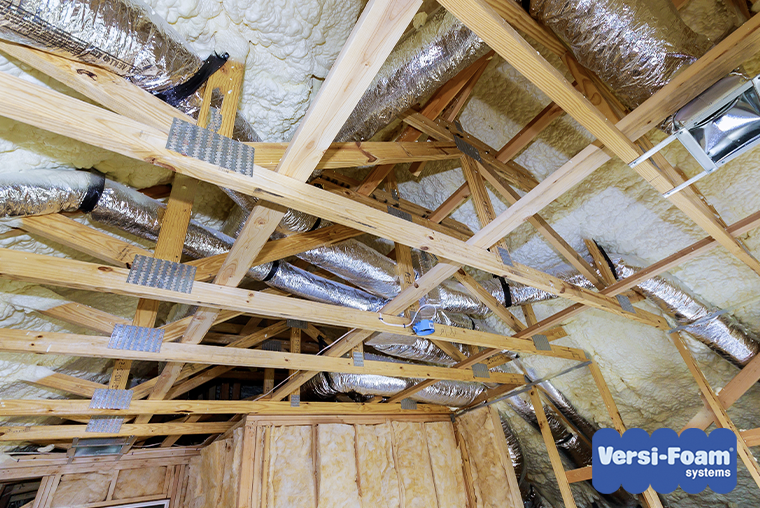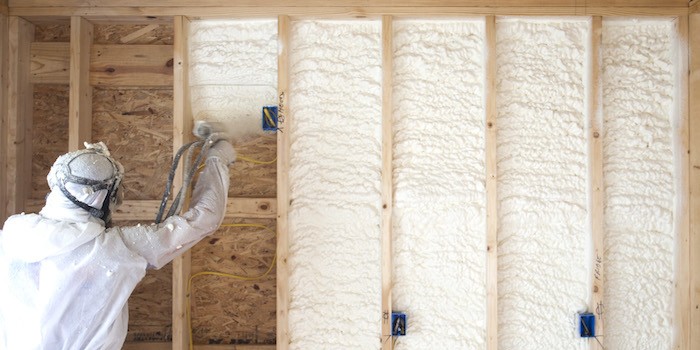Choosing the Right Kind Of Spray Foam for Your Insulation Demands
Choosing the Right Kind Of Spray Foam for Your Insulation Demands
Blog Article
Spray Foam: The Ultimate Solution for Air Sealing and Insulation
Spray foam insulation has arised as a leading solution for efficient air securing and thermal insulation, supplying a distinct mix of residential or commercial properties that establish it apart from typical techniques. Comprehending the full range of its advantages, installation processes, and comparisons with various other insulation types is essential for making educated decisions.
What Is Spray Foam?
Spray foam is a flexible insulation product that incorporates the concepts of air securing and thermal resistance to boost power effectiveness in structures. Composed largely of polyurethane or various other comparable substances, spray foam is applied as a fluid that broadens upon call with surface areas, producing a strong, constant layer of insulation. This special residential or commercial property permits it to fill spaces, cracks, and gaps that typical insulation materials might overlook, supplying a remarkable air seal.
There are 2 main sorts of spray foam: open-cell and closed-cell. Open-cell spray foam is lighter and more versatile, providing superb noise absorption and a reduced R-value per inch - Spray Foam. In contrast, closed-cell spray foam is denser, offering a greater R-value, dampness resistance, and included structural stability to developing elements
The application process generally includes customized equipment, making certain a smooth application that sticks to various substratums, consisting of concrete, metal, and timber. This adaptability makes spray foam suitable for both brand-new constructions and retrofitting existing frameworks. Its capacity to create a closed barrier significantly contributes to reducing energy intake and enhancing interior air quality, therefore making it a favored choice among property owners and builders alike.
Benefits of Spray Foam Insulation
Among one of the most substantial benefits of spray foam insulation is its remarkable capacity to produce a constant air barrier, which effectively decreases power loss. Unlike typical insulation products, spray foam expands to load spaces and fractures, guaranteeing that air leakage is dramatically lowered. This particular not only improves energy efficiency yet likewise results in reduce energy costs over time.
In addition, spray foam insulation supplies premium thermal resistance, adding to a more stable indoor environment. Its high R-value per inch permits effective insulation in constrained rooms, making it excellent for attics, walls, and crawl areas. Moreover, the moisture-resistant residential properties of spray foam assistance stop mold and mildew development, advertising much healthier living problems.
An additional important benefit of spray foam insulation is its sound-dampening qualities (Spray Foam). It effectively lowers noise transmission between spaces, producing a quieter and much more comfortable home setting. The sturdiness of spray foam additionally stands apart, as it does not sag or clear up over time, maintaining its performance throughout its life-span
Just How Spray Foam Functions
Recognizing exactly how spray foam insulation functions is important for appreciating its effectiveness in air sealing and thermal resistance. Spray foam insulation contains 2 primary elements: isocyanate and polyol material. When these elements are mixed, they undergo a chain reaction that causes the product to increase quickly, creating a thick foam that fills up voids, splits, and dental caries.
As the foam broadens, it follows surfaces, forming an impermeable seal that substantially decreases air infiltration. This characteristic makes spray foam insulation very efficient at preventing drafts and wetness penetration, which can have a peek at this site bring about energy loss and damage in time. Furthermore, the closed-cell variation of spray foam uses remarkable thermal resistance due to its inflexible structure, effectively lessening heat browse around here transfer.
The one-of-a-kind buildings of spray foam enable it to conform to uneven surface areas, making certain thorough insurance coverage and a smooth obstacle. As a result, spray foam insulation not just enhances power effectiveness yet also contributes to enhanced indoor air top quality by minimizing the buildup of allergens and pollutants. Inevitably, comprehending the auto mechanics behind spray foam underscores its role as an exceptional selection for insulation and air securing in both business and property applications.
Installation Process Summary

Prior to installation, the area needs to be properly cleansed and prepped, guaranteeing that surfaces are devoid of particles, dirt, and moisture. This action is important because pollutants can endanger adhesion and overall efficiency. As soon as the location is prepared, the application includes mixing both parts of the spray foam, which increases upon contact and fills spaces efficiently.
Trained professionals need to conduct the installation, using customized equipment to make sure consistent insurance coverage and optimum density. Security precautions, including wearing protective gear and making sure proper ventilation, are vital throughout this process. After application, the foam normally cures promptly, creating a strong barrier that boosts energy performance.
Contrasting Spray Foam to Typical Insulation
When reviewing insulation alternatives, spray foam insulation stands out in comparison to traditional materials such as fiberglass and cellulose. Unlike fiberglass and cellulose, which can permit air seepage, spray foam increases upon application, filling voids and gaps to develop an impermeable seal.
Furthermore, spray foam provides a greater R-value per inch than typical insulation kinds, using more reliable thermal resistance in a thinner account. This characteristic is particularly advantageous in spaces with minimal cavity depth. Additionally, spray foam is resistant to dampness and mold development, which can be a considerable worry about cellulose and fiberglass, specifically in damp atmospheres.
Nonetheless, spray foam insulation generally brings a higher in advance expense than its conventional equivalents. Property owners need to evaluate this preliminary financial investment versus long-lasting energy financial savings and efficiency advantages. Ultimately, while both insulation types offer their objective, spray foam arises as Web Site an advanced option for contemporary insulation demands, especially in regards to air sealing and thermal effectiveness.

Conclusion
In summary, spray foam insulation represents an extremely efficient remedy for attaining ideal air sealing and thermal resistance. Its distinct buildings, including dampness resistance and sound dampening, make it suitable for numerous applications in both brand-new buildings and retrofitting jobs (Spray Foam). The first costs might be greater contrasted to standard insulation materials, the long-term benefits, such as considerable energy savings and enhanced interior air top quality, validate the investment and highlight its worth in modern structure methods.
Spray foam insulation has emerged as a leading remedy for efficient air securing and thermal insulation, supplying a distinct mix of buildings that establish it apart from conventional methods.Spray foam is a versatile insulation product that combines the principles of air securing and thermal resistance to enhance energy efficiency in structures.When assessing insulation choices, spray foam insulation stands out in contrast to standard materials such as fiberglass and cellulose. Ultimately, while both insulation kinds serve their purpose, spray foam arises as a much more advanced remedy for modern insulation needs, particularly in terms of air securing and thermal performance.
In summary, spray foam insulation stands for an extremely effective option for achieving optimum air sealing and thermal resistance.
Report this page